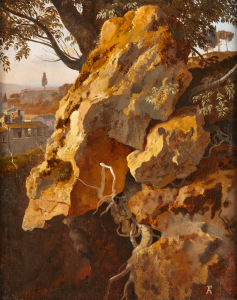Attributed to Josef Ferdinand Fromiller (1693-1760), Vanitas with two putti blowing bubbles
Attributed to Josef Ferdinand Fromiller (1693-1760), Vanitas with two putti blowing bubbles
This small painting shows two putti blowing bubbles using reeds and soapy water in a shell. One of the putti holds the shell in one hand and has already blown a bubble, which is still attached to the reed in his other hand, while the other is attempting to blow a bubble in the shell. The apparent sweetness of this scene is deceptive, however: though disguised as a children’s pastime, the painting actually portrays elements representing the transience and brevity of life. Although soap bubbles are beautiful things to look at, they are quick to burst, and thus serve as a metaphor for the ephemerality of our earthly existence.
The theme of transience was especially popular among painters in Holland and Flanders during the seventeenth century. The word vanitas is Latin and means “vanity” or “emptiness”. Painters used attributes such as skulls, extinguished candles, flowers, decomposed books, musical instruments, clocks and glasses tipped onto their sides to represent the emptiness and impermanence of earthly existence. Although this theme is now considered to have rather sinister connotations, this was not at all the case in the seventeenth century. Death was a more natural part of life then, and people were eager to have their portraits painted with vanitas attributes to demonstrate that they were aware of the inevitability of death. Such images were meant to serve as models of piety. Better to focus on life after death, instead of losing oneself in the delights of earthly life.
This painting can be attributed to the Austrian-born Josef Ferdinand Fromiller (1693-1760), based on an etching by his hand depicting the same scene. The etching carries the subscript: Vita quid est Hominis flos umbraque fumus, which may be translated as “What is the life of man? It is akin to a flower and the shadow of smoke.” Flowers, which wilt and wither, as well as shadows and smoke are typical elements and metaphors in the representation of the transience and impermanence of our worldly existence.
Fromiller was born in Oberdrauburg, in the state of Carinthia, in 1693. He was originally instructed in painting by his father, and later by Ferdinand Steiner, the local artist. He painted large frescos in Trabuschgen Castle, as well as a large number of altar pieces for churches and palace chapels. Fromiller is considered one of the leading Baroque painters from Carinthia, and he left behind a considerable oeuvre. His works are a good example of the Carinthian tradition, which deliberately kept a slower pace in the development of artistic styles.
- Provenance
- Private collection, Germany
- Period
- ca. 1720
- Material
- oil on copper
- Dimensions
- 26.5 x 20.5 cm
Global shipping available









